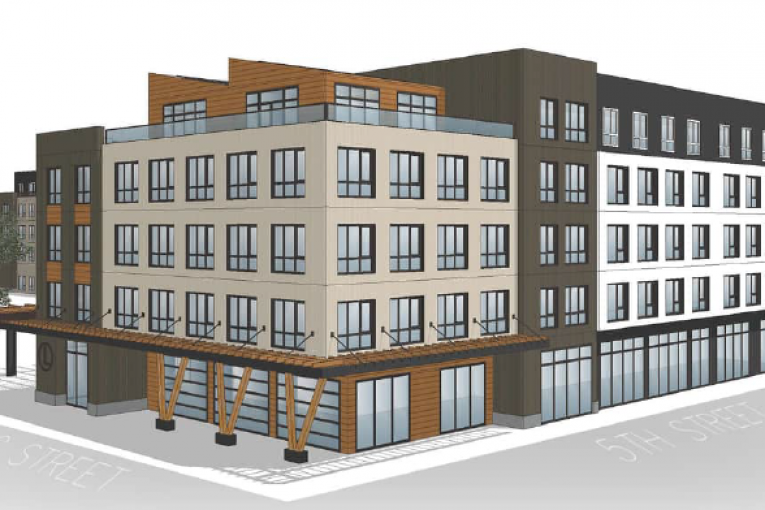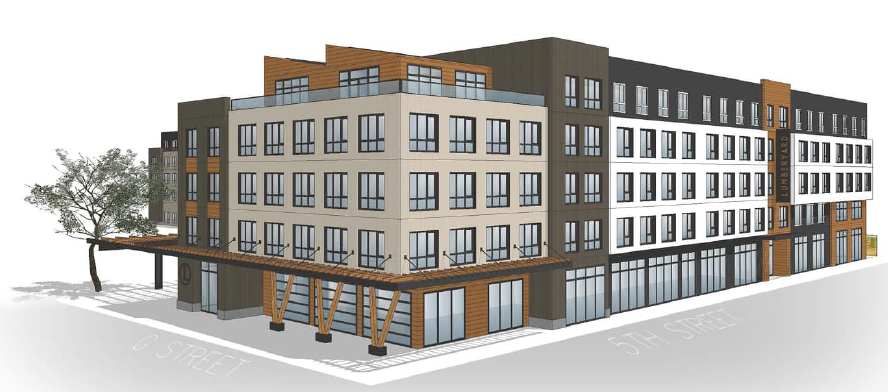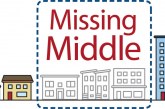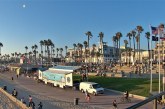

By David M. Greenwald
Executive Editor
Davis, CA – Why do we have a housing crisis not only locally but statewide? Because it’s too difficult to build housing. A recent letter from Old North Davis Neighborhood Association illustrates part of the problem here.
Like many situations we have seen in Davis—these are not people who are anti-housing, but they contribute to an environment where building housing is exceedingly difficult. At the same time, changes in both state and local housing laws, are going to make it difficult this time for neighbors to block or slow the project.
Dave DeYoung, the vice president of the Old North Davis Neighborhood Association, in an op-ed notes, “There is longstanding concern among Davis leaders and residents that there is a significant shortage of affordable housing in the city; simply put, families and those working in the city cannot afford to live here. “
Nevertheless, he has a problem with the Lumberyard project.
He writes, “While the Downtown Davis Specific Plan originally allowed up to a 4-story development for this site, in December the city council, at the request of the developer, voted to increase the number of stories from four to five for the project. Since then, changes to The Lumberyard project increased its number of units, and eliminated any dedicated parking spaces.”
Among the concerns, “The Lumberyard’s lack of any dedicated parking spaces will  significantly affect adjacent neighborhoods and the downtown area.”
significantly affect adjacent neighborhoods and the downtown area.”
He argues, “The city should carefully consider whether the Lumberyard project, as proposed, is consistent with the goals to provide more workforce housing, and allowing more families the opportunity to live in Davis.”
He also complains about the lack of affordable housing: “While the proposed Lumberyard project helps alleviate the city’s housing shortage, it doesn’t do much to help those who can’t afford to live here, since only 11 units, or less than 5% of the total units, are affordable. This is far below the city’s affordable housing ordinance for new rental housing of 15-25%, and makes it more difficult for the city to comply with state housing element law.”
Previously these kinds of complaints had the potential to delay or even kill a project. But that’s going to be much more difficult this time.
The building height issue was already addressed when the City Council approved the Davis Downtown Plan. That means that as long as a project meets the standards of the downtown area in terms of heights, it’s basically a by-right approval which means it is not discretionary.
That was the whole key to getting a new downtown plan—it streamlined approvals so anything that meets the city’s requirements doesn’t have to go through the discretionary approval process and only needs the determination that the project adheres to the requirements of the plan.
In addition, SB 330 passed by the state, which DeYoung rightly sites in his op-ed, locks in the requirements and fees at the time of submission of the pre-application.
A big point of discussion was vertical mixed-use. Currently, the code requires 5 percent affordable for vertical mixed-use. However, if the code as proposed were passed, that number would go up to 15 percent.
But for the Lumberyards the five percent figure is locked in.
There is probably a reasonable debate to be had over whether the project should qualify as vertical mixed-use—but that’s not a debate for the Lumberyards.
According to the letter from the applicant, “Project Sponsor seeks to construct a vertical mixed-use multi-family project with 224 residential and live/work units, a lobby, leasing office, bicycle storage, retail, public fitness center, public co-work…”
While council had a lengthy discussion over what should count for vertical mixed-use—and will have further discussion—it appears that there is enough here that even a more rigorous definition would still qualify.
Councilmember Bapu Vaitla noted last week, “I just don’t think we have a very precise sense of what vertical mixed-use is.”
Partida added, “So I tend to agree that I think it’s really important for us to make sure that a mixed-use project is in fact a mixed-use project. And it’s not like one coffee shop in a corner. That to me is not mixed use.”
She expressed concern, “I am afraid of us completely losing what we call downtown.”
Regardless, with the filing under SB 330, there is no wiggle room here.
That gets us to parking which I discussed at some length in my column on Parking Minimums. The city lacks any kind of discretion here at all.
When the city of Davis approved its Downtown Plan earlier this year, it set the maximum allowed spaces for residential units at .75 spaces per unit for studios and one bedrooms and one per unit for two or more bedrooms. It did away with parking minimums.
That follows a statewide trend. Last September, Governor Newsom signed Assemblymember Friedman’s AB 2097 which would eliminate parking minimums near transit.
AB 2097, a release explained, “abolishes parking requirements within one half mile of major transit stops, meaning developers will no longer be required to build any pre-set minimum number of parking spaces per a residential unit or per square foot of commercial developments.”
With the Amtrak station down the street, this qualifies as being within half a mile of major transit stops and thus, by state law, there is no required parking minimum.
At the end of the day, the Lumberyards is the perfect example of a project that a year ago would have been hammered by process, slowed down, compromised, downsized—and maybe, as we have seen with a few other projects, might not have happened at all.
This will be a good test case to see if a streamlined process actually facilitates housing in Davis.







The question of what qualifies as mixed use should have been clearly and explicitly resolved during the Downtown Plan process.
For this Lumberyards project, all the street-facing frontage should be commercial space that is available for lease. That would mean all the south-facing frontage along 5th Street and all the west-facing frontage along G Street and all the north-facing frontage along 6th Street.
Of the list provided … lobby, leasing office, bicycle storage, retail, public fitness center, public co-work … only the lobby and retail would clearly satisfy the mixed-use street-facing requirements. The leasing office, bicycle storage, fitness center, and public co-work should all be in locations that either are within the core of the building (in a corridor behind the street-facing units) or on the east-facing side of the building along the railroad tracks.
Having the second or even third floor of vertical mixed use locations be offices or service businesses like Gyms is totally normal… no reason why the commercial parts of the building have to be relegated to the ground floor.
I like the idea of trying to keep retail stores on the ground floor for walk-by shopping type of access… places like Gyms and co-working dont need ground-level access.
That configuration works for me Tim. The key is having the street facing spaces on the first floor be retail or walk-in services. Bicycle storage on the first floor seems to be more practical as well … especially if the residents are forsaking having a car.
Hibbert’s Hijinks
The building is 207.448 square feet in size in five stories and 8,586 square feet is classified non-residential 4.1% of the building is non-residential and that qualifies as mixed use?
Not by my book and not probably by most people.
This is a sizable statue of David that has a fig leaf of retail.
I know of a bar in a blue county in Pennsylvania where it is illegal for the front door of the bar to be open on Sunday. However, if you use the side door on Sunday then you have not broken the law.
For me, this is too much of a loophole. The city should have anticipated this probable misuse. Does the city have proportions of retail to residential to avoid this vacuum?
The Downtown Plan was certainly done to grow downtown but what I think was envisioned was ground floor all retail or services and housing above. That format was a good one as it creates a more vibrant downtown. However, The 200+ resident vehicles that need to park somewhere will stuff the area and make parking for retail much more difficult.
We better be on notice as downtown could end up being almost all housing.
I certainly do not want a downtown which ends up being 4.1% retail and 95% residential.
Your comment is similar to what Matt noted, above:
Regarding the following:
The theory here being two-fold:
1) Residents living downtown will “replace” existing customers.
2) No one living downtown (or their visitors) have cars (or access to cars), anyway.
In any case, it’s probably going to be 90% occupied by students, along with the the other two proposals.
In my opinion, one cannot (successfully) argue against (XX proposal, in “their” neighborhood) by starting out with an appeasement to the “housing shortage people”. I saw this with Trackside, as well.
This “appeasement” is the reason that neighborhoods repeatedly find themselves in a “predicament”, in which they’re then called “NIMBYs”. This is also related to how folks like Wiener, Newsom, and Bonta got elected. (The system limits the “choice” that voters are given.)
I find it sad and concerning when some folks do this. It’s “legitimate” to say that you’re slow-growth, that you don’t want downtown to turn into a giant residential development (which overshadows the surrounding neighborhood), that you don’t believe that new residents are somehow “car-free”, and that you don’t support sprawl.
There is no housing shortage. It’s “made-up”, “fake news”. Seriously. Pretty sure I can dig up a video which shows that there’s more “houses per person” (nationwide) than at any time in history. And no, they’re not all in Detroit.
There’s not even any “local workers” to speak of, other than a relative handful – who already have a home.
Again, those starting off with an appeasement have already lost the battle (and war).
I suspect that these appeasements are partly “tactical” – but it’s not going to result in success. Your own words can, and will be used against you.